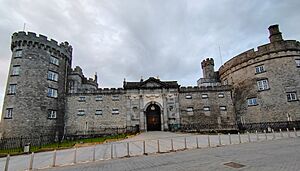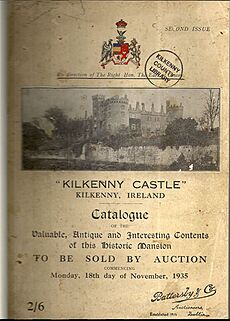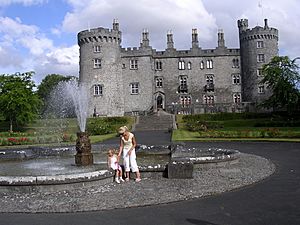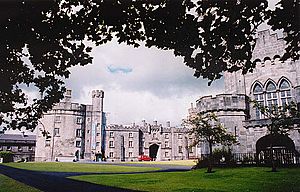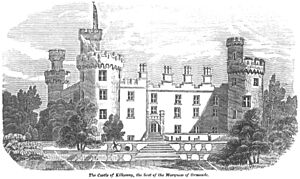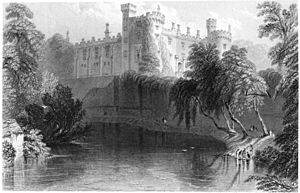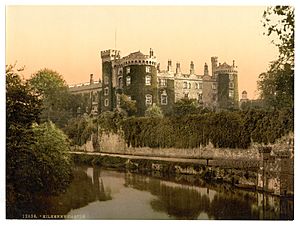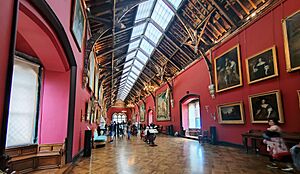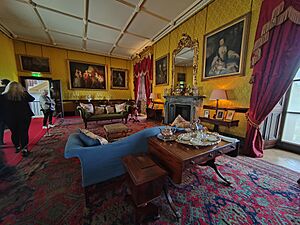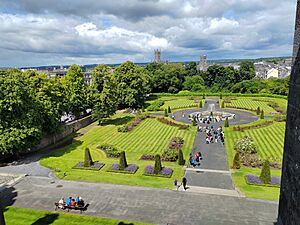Kilkenny Castle facts for kids
Quick facts for kids Kilkenny Castle |
|
|---|---|
|
Irish: Caisleán Chill Chainnigh
|
|
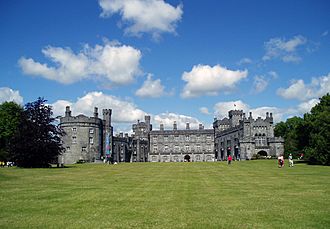 |
|
| General information | |
| Type | Castle |
| Location | Kilkenny, Ireland |
| Completed | 1260 |
Kilkenny Castle (Irish: Caisleán Chill Chainnigh) is a famous castle in Kilkenny, Ireland. It was built a long time ago, in 1260, to help control a crossing point on the River Nore and where several roads met. It was a very important building for the people who came from England and France to settle in Ireland. When it was first built, it had four big round towers at its corners and a huge ditch around it, which helped protect the town. You can still see parts of this ditch today!
In 1967, a man named Arthur Butler, 6th Marquess of Ormonde, sold the castle for a very small amount of money (£50) to a group that wanted to fix it up for the people of Kilkenny. Now, the castle and its beautiful grounds are looked after by the Office of Public Works, and everyone can visit the gardens and park. One part of the castle, the Parade Tower, is even used for meetings and events. Since 2002, students from the Kilkenny Campus of the National University of Ireland, Maynooth, have their graduation ceremonies at the castle, which is a very special event!
Contents
Discover Kilkenny Castle
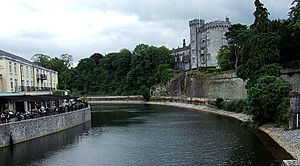
A Look Back in Time
Building the First Castle
The very first castle here was probably made of wood and built in the 12th century by a powerful leader named Richard de Clare, also known as Strongbow. People from England and France, called Anglo-Normans, had already built a castle in 1173, possibly where an older home of the local Mac Giolla Phádraig kings of Osraighe once stood. Kilkenny was part of a large area called Leinster, which was given to Strongbow.
Strongbow's daughter, Isabel, married William Marshall in 1189. William Marshall owned many lands in Ireland, England, Wales, and France, and he was very good at managing them. In 1192, he put Geoffrey FitzRobert in charge of Leinster as his seneschal. This started a big building project in Kilkenny, including the development of Kilkenny Castle. The first castle made of stone was finished in 1260. It was square-shaped with towers at each corner. Three of these original four towers are still standing today!
The castle was later owned by Sir Gilbert De Bohun. He inherited it in 1270. Even though he faced some challenges, he held onto the castle until he passed away in 1381. After that, the castle was sold to the Butler family in 1391.
The Butler Family's Home
The Butler family (who changed their name from FitzWalter in 1185) came to Ireland with the Norman settlers. They first lived in a place called Gowran where James Butler, 3rd Earl of Ormond built Gowran Castle in 1385. The family became very rich, and James bought Kilkenny Castle in 1391. He then became the main ruler of the area. The Butler family continued to be powerful in this region for many hundreds of years. Many members of the family, including James Butler, are buried in St. Mary's Collegiate Church Gowran.
One famous member of the Butler family was Lady Margaret Butler (born around 1454 or 1465). She was an Irish noblewoman and the daughter of Thomas Butler, 7th Earl of Ormond. Lady Margaret Butler was born right here in Kilkenny Castle! She married Sir William Boleyn and was the grandmother of Anne Boleyn, who became the second wife of King Henry VIII of England.
Times of Change and Conflict
In the 17th century, the castle became the property of Elizabeth Preston, who was married to the then Lord Lieutenant of Ireland, James Butler, 1st Duke of Ormond. James Butler was a Protestant, unlike most of his family. During a period of fighting in Ireland in the 1640s, he represented King Charles I of England. However, his own castle became the main meeting place for a Catholic group called Confederate Ireland. Their parliament, or "Supreme Council," met in Kilkenny Castle from 1642 to 1648. At this time, Ormonde himself was living in Dublin.
The east wall and the northeast tower of the Castle were damaged in 1650. This happened during the siege of Kilkenny by Oliver Cromwell's forces, who were conquering Ireland. These damaged parts were later taken down. Then, in 1661, after returning from being away, Butler rebuilt the castle to look more like a "modern" grand house or château.
By the 18th century, the castle started to look a bit old and worn, as the Butler family's wealth was not as great. But some repairs were done by Anne Wandesford of Castlecomer, who brought more money into the family when she married John Butler, the 17th Earl of Ormonde. In the 19th century, the Butlers tried to make the castle look like its original medieval self again. They rebuilt the north wing and made the south wall longer. More additions were made in 1854. In 1904, King Edward VII of the United Kingdom of Great Britain and Ireland and his wife Queen Alexandra even visited Kilkenny Castle!
The Castle in the 20th Century
The Butler family sold most of their rented lands in Tipperary and Kilkenny, about 21,000 acres (85 km2), by 1915 for £240,000. James Butler, 3rd Marquess of Ormonde, passed away in 1919. There were large taxes and costs to pay after his death, amounting to £166,000.
Since Lord Ormonde only had two daughters, it was decided that his brother and heir, Arthur Butler, 4th Marquess of Ormonde, would let his son, George Butler, 5th Marquess of Ormonde, inherit the estate to reduce taxes. Lord and Lady Ossory (George and his wife) moved into the Castle in 1921 with their children, Antony and Lady Moyra Butler.
In 1922, during the Irish Civil War, some Republican fighters were trapped inside the Castle by forces from the Irish Free State. The Ormonde family, along with their pet Pekinese dog, decided to stay in their bedroom above the great gate, which was where most of the fighting was happening. There was even a machine gun right outside their door! Only one man was injured, but the castle was badly damaged, and it took many years to fix.
George Butler, Earl of Ossory, and his family continued to live in the castle until 1935. At that point, they sold everything inside the castle for £6,000, moved to London, and left the castle empty for thirty years. Rising taxes, costs after deaths in the family, economic problems, and living costs had made it too expensive to keep. While the Ormondes had received £22,000 in rental income in the 1880s, investment income in the 1930s was around £9,000, and by 1950, these investments yielded only £850.
In 1938, Arthur, George, and Antony Butler made new plans for how the family's properties would be managed. Sadly, Antony Butler, Viscount Thurles, passed away unexpectedly in 1940. So, after the deaths of the 4th Marquess in 1943 and the 5th Marquess in 1949, the estate was inherited by Arthur Butler, 6th Marquess and 24th Earl of Ormonde.
In 1967, this Lord Ormonde sold the castle, which was empty and falling apart, to the Castle Restoration Committee for a symbolic £50. He said, "The people of Kilkenny, as well as myself and my family, feel a great pride in the Castle, and we have not liked to see this deterioration. We determined that it should not be allowed to fall into ruins. There are already too many ruins in Ireland." He also bought the land in front of the castle from the family's trustees. He did this so that nothing would ever be built there, and the castle could always be seen in all its dignity and splendor. The event where the castle was handed over also started The Butler Society, an organization that is still active today, connecting and preserving the history of this important family. Even famous singer Mick Jagger and Marianne Faithfull came to the party! Now, Kilkenny Castle belongs to all the people of Kilkenny.
What You Can See Today
The rest of the 20th century involved a lot of work to fix up and take care of the castle. It was also opened for visitors to explore!
Art at the Castle: Butler Gallery
The Butler Gallery used to be in the basement of Kilkenny Castle. Now, it's in a renovated building called Evans' Home, which was once a place for servants who needed help in the 1800s. The gallery hosts changing art shows organized by the Kilkenny Art Gallery Society. It's named for Peggy and Hubert Butler.
Uncovering Hidden Secrets: Excavations
Archaeologists like Ben Murtagh did excavations and building surveys in the 1990s. They found signs of an even older castle! They also uncovered a hidden side entrance (called a postern gate) and a part of the castle's ditch that faces the Parade area, which you can see now. They even partly found the missing southeast side of the castle. The original entrance was through the east wall, which is no longer there. Other parts of the first castle have also been found, including original stone supports and a garderobe (an old type of toilet). In 2019, another archaeologist, Cóilín Ó Drisceoil, found the foundations of the main gatehouse, which William Marshal built in the early 1200s.
A Record-Breaking Day
Kilkenny Castle holds a special weather record! Ireland's highest official air temperature ever recorded, which was 33.3 °C (91.9 °F), was measured at Kilkenny Castle on June 26, 1887.
Burials at the Castle
- Aoife MacMurrough
See also
 In Spanish: Castillo de Kilkenny para niños
In Spanish: Castillo de Kilkenny para niños


